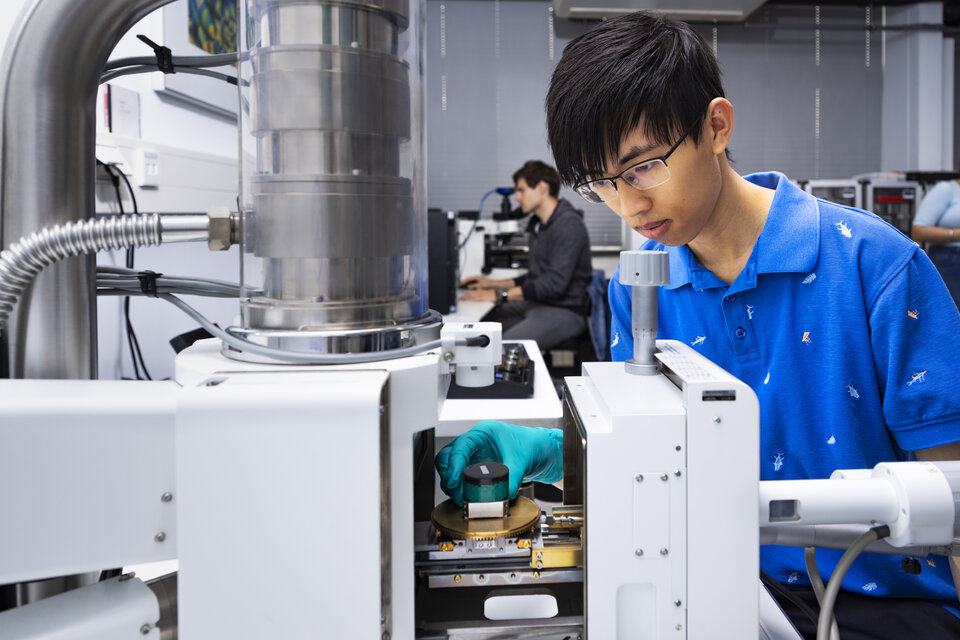Reproducing a 3,000-year-old sword for your graduation project. Materials Science & Engineering student Dorien Westert is combining archaeology and materials science by studying the microstructure of iron swords. In the process, she may learn more about the smithing skills and rituals of the people in the Early Iron Age.
Intentionally mutilated weapons and other objects are often found in ancient graves from the Iron Age. In the Netherlands, several bent iron swords have been discovered from the Hallstatt C period of the early Iron Age, i.e. around 800 BC to 600 BC. The most famous bent sword was found in the Chieftain’s grave (Vorstengraf) of Oss and was ‘rolled up’ in a situla, a kind of bronze bucket.
Given the size of the tomb, the mourners could have chosen to place the sword next to the bronze situla, but instead they took the time and effort to bend it. This raises the question: How were these swords bent, by brute force or by heating and hammering? Could this have been done during a cremation or was it necessary to take the sword to a blacksmith?
What exactly have you been researching?
I studied the microstructure of Dutch bent iron sword from the Early Iron Age. These swords are bent a bit like St. Nicholas’ staff (in the Dutch tradition) or even folded. Metallographic research methods are used to investigate how these swords were bent. Many treatments, like iron or sword production and bending, leave small traces in the object such as characteristic metal microstructures, deformations, defects or residual stresses. Analysing all these microstructural features eventually lead to a better picture of the biography of the objects and the metal knowledge of the people in the Early Iron Age.
Why is this research important?
The fact that these swords are among the first iron objects from the Netherlands is extraordinary in itself. Little is known about the microstructure of these ancient objects in our country. Understanding how these swords were bent tells us something about the knowledge, skills and equipment of the people of that time and thus contributes to the archaeological framework of the Hallstatt culture in the Netherlands. What did they already know about blacksmithing? What didn’t they know? How good were they at making objects, and what exactly is done during a funeral ceremony? There are already archaeological theories as to why the swords are bent, and of course it would be great if we could confirm or support these theories with material research.
Can you tell us more about your research method?
First, a replica was made. This was a very interesting and fun experience. Blacksmith Thijs van de Manakker offered his experience and knowledge of old fashion smithing; He helped forge the replica and bent it with different techniques. One part was bent with brute force and a leverage effect, one part was bent by reheating and hammering and the last part was left straight as a control. The microstructure of these “mock-up” parts was analysed and compared to determine the effect of different bending techniques.
Microscopy was definitely the biggest part of the work. I made cross-sections of the replica and examined them with SEM-EBSD, SEM-EDS* and optical microscopy, as well as one sample from the Heythuizen sword, one of the 3000-year-old bent swords. Subsequently, EPMA** was used to examine the carbon concentration throughout the iron samples, suggesting the use of wrought iron and hardening techniques. Furthermore, the microstructure of some of the museum objects was analysed using a non-destructive technique to reveal structural information of crystals and metals (ToF-ND).
*SEM (scanning electron microscope) is an electron microscope that makes the microstructure of materials visible to the human eye.
**EPMA (electron probe microanalyzer) is an analytical tool used to determine the chemical composition of small volumes of solid materials.
What was your greatest challenge and what did you enjoy the most?
The greatest challenge was bringing together historical and archaeological science with materials science. Writing my thesis in a way that both historians and engineers could understand.
What I enjoyed most was visiting museums, such as the National Museum of Antiquities and the Valkhof Museum, and taking a look behind the scenes. There’s a whole world behind the organisation, conservation, maintenance and research of cultural heritage objects. I found out how complicated it is to actually examine a small sample of an archaeological object. Of course, you can’t just use a museum piece to make a cross-section, but luckily I had the replica for that. It was also great to work at the laboratory of Cultural Heritage Agency of the Netherlands and see how much and what kind of technical research is being done on all kinds of cultural heritage and to see the experts at work.
What’s the next step? Do you plan to do follow-up research or do you intend to do something with the results?
My research is not complete yet, but together with the Cultural Heritage Agency lab, I will continue with the research after the thesis. A publication would be great and provide museums with valuable information.
What knowledge from your Master’s degree were you able to use in your thesis?
An incredible amount! I used knowledge from subjects such as metals science, corrosion science, determination of microstructures, characterisation of materials, thermodynamics and kinetics of materials, structure and properties of materials. This research covered a surprisingly wide area of materials science.
Choice of programme
Dorien Westert, master student Materials Science & Engineering
Why did you choose to do a Master’s degree in Materials Science & Engineering?
I chose the Master’s programme with the aim of researching cultural heritage materials. I’m fascinated by how much information is concealed in the materials of art and history. Personally, I’m very interested in the technical side of things, which is why I chose this Master’s programme. How does a material change colour? How does it disintegrate? How does it age and what changes with age? What is it made of and how does this influence the material? But also, what’s important for future generations?
Dorien was supervised by Prof. Dr. Maria J. Santofimia Navarro, Dr. Matthias Alfeld and Dr. Ineke Joosten.

![[Translate to English:] Picture of curled sword from the iron age](https://filelist.tudelft.nl/_processed_/f/4/csm_museumhetvalkhof-gebogen-zwaard-ijzertijd_33776c7ff7.jpg)
![[Translate to English:] Picture of microscopic analysis iron sword on computer](https://filelist.tudelft.nl/me/Onderwijs/Student%20Stories/rce-amsterdam-onderzoek-zwaard-ijzertijd.jpg)
![[Translate to English:] Picture of iron sword under microscope](https://filelist.tudelft.nl/_processed_/6/4/csm_microscopie-zwaard-ijzertijd_83aa9f9493.png)
![[Translate to English:] Picture of the researchers analyzing iron at the museum](https://filelist.tudelft.nl/_processed_/3/3/csm_archeologisch-onderzoek-zwaard-ijzertijd_c57d3b1e3c.jpg)
![[Translate to English:] Picture of materials student analyzing iron](https://filelist.tudelft.nl/me/Onderwijs/Student%20Stories/onderzoek-zwaard-ijzertijd.jpg)

